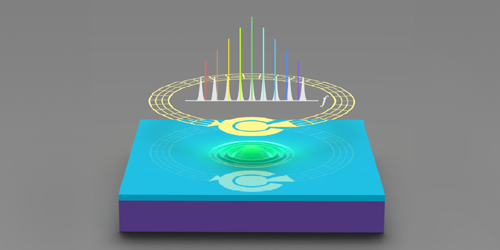Oscillating into the GHz Regime
Nonlinear mechanical oscillators are increasingly found in devices ranging from signal processors to high-precision accelerometers. Typically, such oscillators can only resonate at frequencies of up to a few MHz; at higher frequencies, their structures are too stiff to vibrate properly, and they produce linear, rather than nonlinear, responses to stimuli. Now, Xu Han and his colleagues at Yale University have made a nonlinear oscillator that works at GHz frequencies [1].
The team’s device consists of a mechanical oscillator coupled to a nonlinear superconducting resonator. The mechanical part is a piezoelectric “bulk acoustic resonator” (BAR)—a 500-µm-thick slice of silicon topped with an aluminum nitride thin film—while the superconducting part is a capacitor whose two terminals are connected by a high-kinetic-inductance superconducting ring. This nonlinear superconducting resonator typically vibrates at around 10 GHz, but its exact oscillation frequency depends on the ring’s kinetic inductance, which varies nonlinearly with current.
The coupling between the BAR and the superconducting resonator is such that the superconducting part nonlinearly amplifies oscillations supported by the BAR. Han and colleagues also show that, when the superconducting resonator is driven by a microwave tone at its resonant frequency, the BAR produces an acoustic frequency “comb”—a series of mechanical oscillations at evenly spaced frequencies in the 10 GHz part of the spectrum.
Frequency combs are already used in frequency metrology and remote sensing. But the sensitivity of devices operating at MHz frequencies can be limited by thermal noise. Such noise scales inversely with the resonant frequency and is thus weaker at GHz frequencies, meaning the new system could find use in applications where noise is a particular problem, such as quantum signal processing.
–Marric Stephens
Marric Stephens is a Corresponding Editor for Physics Magazine based in Bristol, UK.
References
- X. Han et al., “Superconducting cavity electromechanics: The realization of an acoustic frequency comb at microwave frequencies,” Phys. Rev. Lett. 129, 107701 (2022).




